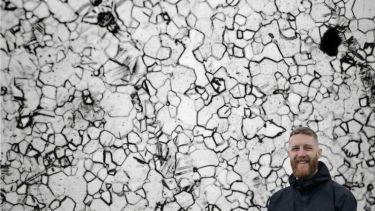A project led by Mike White, AMS CDT PhD Researcher based at The University of Manchester, partners with Rolls-Royce to develop a framework for quantitatively describing microstructure in a concise manner to aid in a range of tasks, such as microstructure characterisation, quality control processes, and alloy design.
This research has also been supported by the Department of Mathematics at The University of Manchester and the Materials Research Centre at the Indian Institute of Science, Bangalore, India.
Why is this Important?
Drawing links between processing routes and mechanical properties for materials is crucial for the efficient design of novel alloys. Leveraging microstructural information as a bridge between processing routes and mechanical properties has been proven to be effective; however, current methods for describing microstructure are often qualitative, or discard significant amounts of information, which potentially gives scope for inaccuracy.
Following the inception of computer vision and machine learning, a plethora of tools have been made available for describing image data. These tools are yet to be fully exploited within the field of materials science.
This project aims to identify and test such methods, with the aim of constructing a ‘microstructural fingerprint’, which captures the intrinsic properties of microstructure in a compressed format, whilst preserving as much information as possible. Long-term, these methods have the potential for substantial time savings, and therefore reduction in the costs associated for processes such as alloy design, which can be extremely time-consuming and high cost.
Underpinning Research
Numerous literatures relating to constructing process-property relationships for materials, and the importance of leveraging microstructural information in the process, has been published. This has resulted in various methods for including microstructure data being proposed as a caveat of this. However, there has been little emphasis on simply seeking out optimal representation of microstructure data that are application independent.
This project aims to bridge the knowledge gap in this area by systematically evaluating various methods for fingerprint construction in a range of tasks, with a focus on identifying process-structure-property relationships.
Current Findings
In a bid to develop the ‘microstructural fingerprint’, Mike’s research thus far has tested several methods for fingerprint construction, which resulted in solving a classification task with competent performance.
Relationships between process parameters and microstructure have been drawn successful in some cases, namely between deformation temperature and fingerprints constructed from SEM images.
Relationships have also been sought between SEM images and hardness measurements, but at the time of writing the results were inconclusive. This is likely due to insufficient information contained in SEM image data. As a result of this, fingerprints constructed from EBSD data are now being investigated to provide the missing links.
Next Stages
Although a robust framework is currently in place for constructing fingerprints [due to current findings], technological advancements in the field mean there are still many avenues in need of exploration. The next stages of this project involve building a novel dataset, which should enable the verification of potential applications for the methods being developed.
There will be a focus on constructing process-structure-property relationships, where the structure is described by fingerprints constructed from various image-based datasets and seeking correlations between the fingerprints and processing parameters/mechanical properties.
Analysis will also be performed to compare fingerprints constructed from similar alloys to quantify disparity between similar microstructures. This could aid in quality control processes, where consistency across separate batches of material is crucial.
Long-term, these methods have the potential for substantial time savings, and therefore reduction in the costs associated for processes such as alloy design.
Equipment and Facilities
The University of Manchester Computational Shared Facility (CSF3) has been utilised for running simulations.


